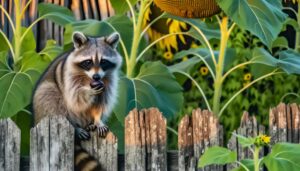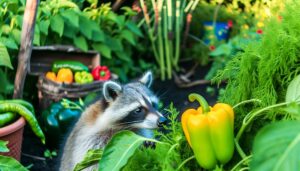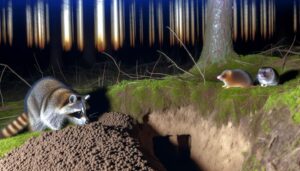Do Raccoons Eat Potato Plants?
Raccoons, as nocturnal omnivores with highly developed tactile senses, may target potato plants, particularly when alternative food sources are insufficient. While direct evidence is sparse, raccoons can cause notable damage to potato crops by uprooting tubers and disturbing soil.
Indicators of their presence include irregular bite marks on tubers, nocturnal soil disruption, and characteristic paw prints. Farmers can mitigate damage through evidence-based methods such as physical barriers, natural deterrents like capsaicin and garlic oil, and humane relocation.
Those seeking to safeguard crops against raccoons and other garden pests, like aphids and slugs, will benefit from integrated pest management strategies.
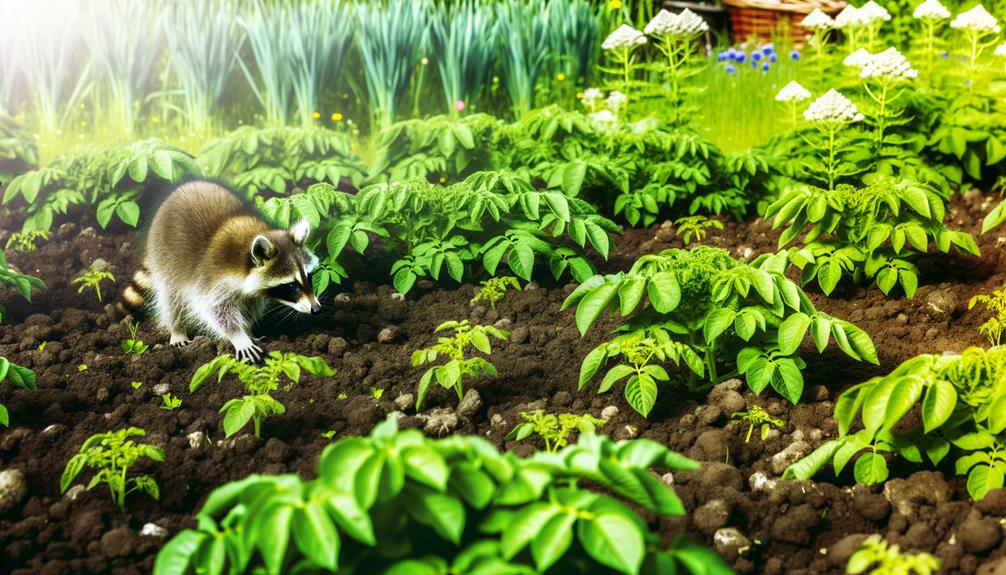
Key Takeaways
- Raccoons are omnivores but potato plants are not their primary food source.
- Evidence suggests raccoons can significantly damage potato crops when foraging.
- Uprooted tubers and disturbed soil are signs of raccoon activity around potato plants.
- Farmers can use physical barriers and natural deterrents to protect potato crops from raccoons.
- Companion planting with marigolds, garlic, onions, and peppermint can help deter raccoons.
Raccoons' Dietary Preferences
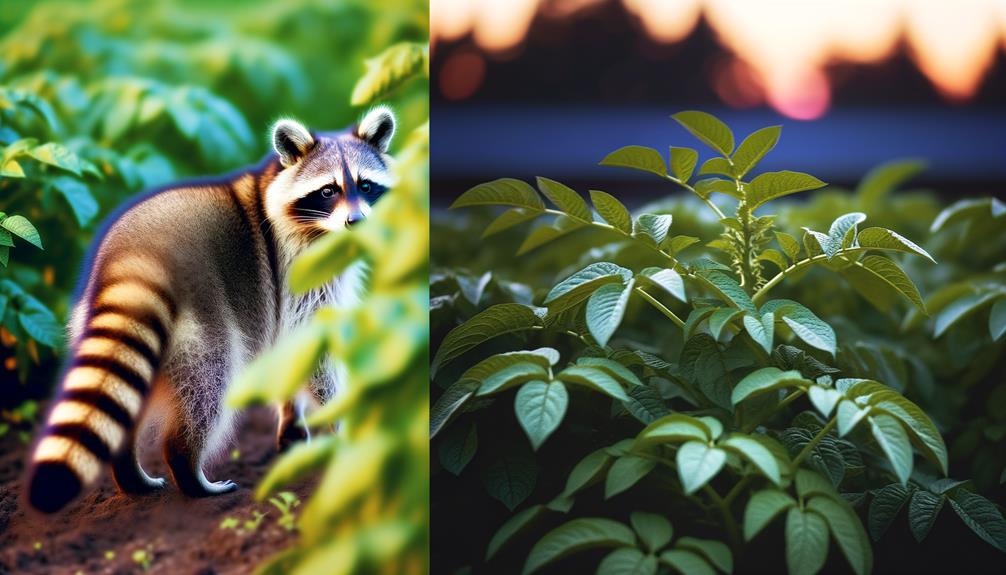
Raccoons exhibit omnivorous dietary preferences, frequently consuming a diverse array of food sources including fruits, vegetables, insects, and small animals. This dietary versatility is supported by their highly developed tactile sense and dexterous forepaws, enabling them to manipulate and investigate potential food items efficiently.
Studies have shown that raccoons adjust their foraging behavior based on food availability, demonstrating behavioral plasticity. Nutritional analyses reveal that raccoons derive essential vitamins and minerals from their varied diet, contributing to their adaptability in different habitats. Evidence indicates that raccoons exploit both natural and anthropogenic food sources, highlighting their opportunistic feeding strategy.
This omnivorous diet is a key factor in the raccoon's ecological success and widespread distribution across North America.
Potato Plants: Are They at Risk?
Given their omnivorous dietary preferences and opportunistic feeding strategies, it is relevant to explore whether potato plants are susceptible to predation by raccoons. While raccoons are known to consume a diverse array of food sources, such as fruits, vegetables, and small animals, direct evidence of raccoons specifically targeting potato plants remains limited.
However, raccoons' tendency to forage in agricultural areas suggests potential risk. Studies indicate raccoons may uproot plants to access tubers, thus causing significant damage to potato crops. Although potatoes are not a primary food source for raccoons, their behavior demonstrates sufficient flexibility to exploit available resources, including potato plants.
Therefore, it is crucial for farmers to assess the potential vulnerability of their potato crops to raccoon activity.
Signs of Raccoon Activity
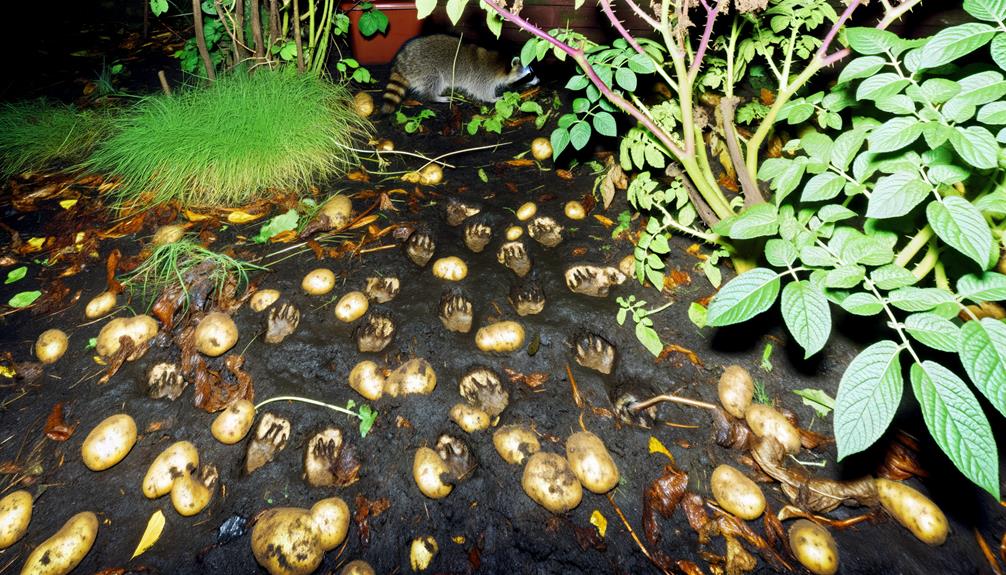
Detecting raccoon activity around potato plants often involves identifying specific signs such as uprooted tubers, disturbed soil, and characteristic paw prints.
Raccoons typically have five-toed paw prints with a distinct heel pad, which can be discerned in soft mud or soil. Additionally, raccoons are nocturnal foragers, so signs of nighttime disturbance, such as overturned soil and scattered plant debris, are indicative of their presence.
Bite marks on tubers can also serve as evidence, often presenting as irregular, jagged edges due to raccoons' omnivorous dentition. Further confirmation can be obtained through the presence of fecal matter, which may contain undigested potato fragments.
These indicators collectively provide a reliable method for diagnosing raccoon interference in potato cultivation.
Preventing Raccoon Damage
Preventing raccoon damage to potato plants necessitates an evidence-based approach. This includes incorporating physical barriers such as fencing, the use of natural deterrents, and the strategic implementation of trapping and relocation.
Research indicates that robust fencing can reduce raccoon intrusions to a considerable extent. Natural deterrents like predator urine have been shown to be effective in smaller-scale studies.
Additionally, humane trapping and subsequent relocation can serve as a last resort, ensuring minimal impact on local ecosystems.
Fencing and Barriers
Implementing efficient fencing and barriers is crucial for mitigating raccoon damage to potato plants. These structures provide a physical deterrent that can greatly reduce the likelihood of raccoon intrusion. High-tensile wire mesh with apertures no larger than 1 inch can be particularly effective, as raccoons are skilled climbers and squeezers.
Electrified fencing offers an additional layer of protection by delivering a mild shock upon contact, dissuading persistent raccoons. Barriers should extend at least 12 inches underground to prevent burrowing. Empirical studies have shown that a combination of vertical height (minimum 4 feet) and horizontal barriers notably decreases raccoon activity in agricultural settings.
Proper maintenance and regular inspections guarantee the longevity and efficacy of these protective measures.
Natural Deterrents
In addition to physical barriers, employing natural deterrents such as predator urine, strong-smelling plants, and motion-activated sprinklers can effectively reduce raccoon damage to potato plants by exploiting the animals' sensory aversions and territorial instincts. These deterrents function by creating an environment that raccoons find uninviting or threatening.
Evidence-based approaches include:
- Predator Urine: Utilizing urine from natural raccoon predators (e.g., coyotes) can simulate the presence of threats.
- Strong-Smelling Plants: Planting marigolds or garlic around potato plants can repel raccoons due to their potent aromas.
- Motion-Activated Sprinklers: Sudden bursts of water can startle raccoons, encouraging them to avoid the area.
- Cayenne Pepper: Sprinkling cayenne pepper around plants can deter raccoons through irritation of their sensitive nasal passages.
These methods leverage behavioral ecology principles to minimize raccoon intrusions.
Trapping and Relocation
Trapping and relocating raccoons can be an effective strategy for preventing damage to potato plants. This method involves using humane live traps, typically baited with food attractive to raccoons, such as fruits or peanut butter. Once captured, raccoons should be relocated to a suitable habitat at least 10 miles away to prevent their return.
Importantly, relocation must consider the ecological impact on both the destination and source environments. Evidence suggests that improper relocation can lead to increased mortality due to unfamiliarity with the new habitat. Hence, it is essential to consult local wildlife authorities to guarantee compliance with legal and ethical standards, optimizing both human and animal safety.
Safe Repellents for Gardens
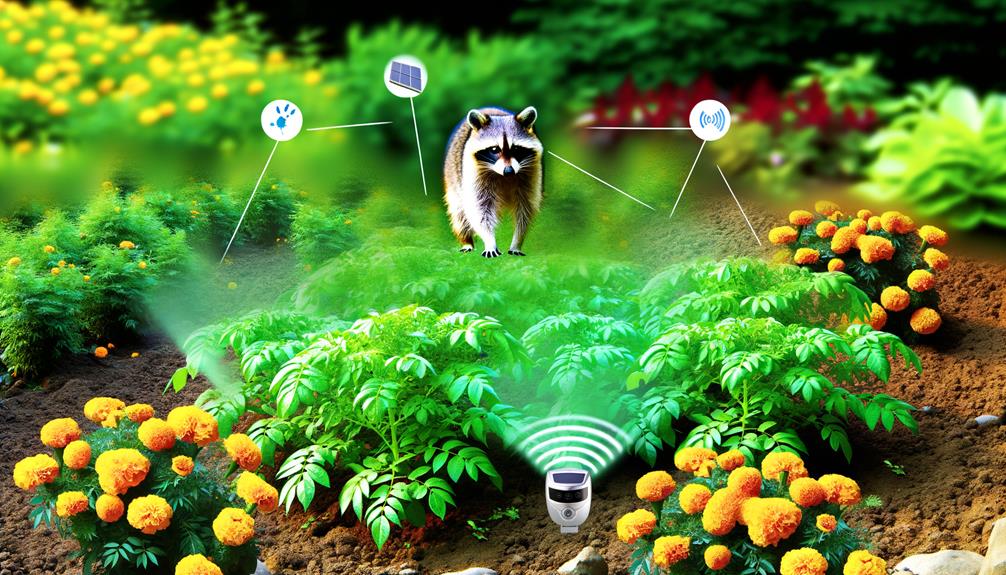
Employing safe repellents in gardens is critical to mitigating raccoon activity without resorting to harmful chemicals. This can be achieved through natural deterrent methods such as the use of predator urine or essential oils. Homemade repellent recipes involving ingredients like hot pepper are also effective. Companion planting strategies that incorporate plants raccoons find unappealing play a key role in deterring them.
Evidence suggests these approaches can effectively reduce raccoon incursions by leveraging their sensory aversions and behavioral tendencies.
Natural Deterrent Methods
Effective natural deterrent methods for protecting potato plants from raccoons include the strategic use of specific botanical repellents and the application of environmentally safe substances. Evidence-based approaches involve leveraging the olfactory aversion of raccoons to certain plants and compounds.
Key natural deterrents include:
- Cayenne Pepper: Capsaicin, the active component, irritates raccoons' mucous membranes.
- Garlic Spray: Contains sulfur compounds that raccoons find repulsive.
- Blood Meal: A nitrogen-rich fertilizer that emits a scent reminiscent of predators.
- Epsom Salt: Magnesium sulfate disrupts the sensory pathways of raccoons.
These methods not only safeguard potato plants but also maintain ecological integrity, thereby promoting sustainable gardening practices.
The efficacy of these repellents is supported by both anecdotal evidence and scientific research, ensuring their reliability in practical applications.
Homemade Repellent Recipes
Frequently, homemade repellent recipes leverage a combination of botanical extracts and common household ingredients, which have demonstrated efficacy in deterring raccoons from garden areas.
Capsaicin, derived from chili peppers, is a potent irritant that affects raccoons' mucous membranes, discouraging their presence.
Additionally, garlic oil, containing allicin, acts as a natural repellent due to its strong odor and potential irritant properties.
Vinegar, with its acetic acid content, can alter the scent profile of the garden, making it less attractive to raccoons.
Scientific studies have documented the effectiveness of these substances in wildlife management, providing an evidence-based approach to mitigating raccoon interference.
Combining these ingredients into a spray formulation can offer a safe, non-toxic method to protect potato plants and other garden flora.
Companion Planting Strategies
Integrating companion planting strategies into garden design can serve as a biologically-based method to deter raccoons and protect potato plants. Evidence suggests certain plants emit volatile organic compounds that raccoons find unappealing. This strategy not only reduces reliance on synthetic chemicals but also fosters ecosystem diversity.
Effective companion plants include:
- Marigolds: Their strong scent masks the odor of potato plants.
- Garlic: Known for its potent smell, it acts as a natural deterrent.
- Onions: Emit sulfur compounds that raccoons dislike.
- Peppermint: Contains menthol, which raccoons find irritating.
These plants can be strategically interplanted with potatoes, creating a multifaceted barrier. Employing these methods enhances garden health while safeguarding crops from nocturnal foragers.
Other Potential Garden Pests
In addition to raccoons, a variety of other garden pests such as aphids, slugs, and deer can greatly impact the health and yield of potato plants. Aphids (Aphidoidea) are small, sap-sucking insects that can cause stunted growth and transmit plant viruses. Slugs (Gastropoda) feed on foliage, leaving irregular holes and increasing susceptibility to secondary infections. Deer (Cervidae) may graze on both foliage and tubers, leading to significant crop loss.
Integrated pest management (IPM) strategies, including physical barriers, natural predators, and selective pesticides, are essential for mitigating these threats. Evidence from agricultural studies suggests that early intervention and continuous monitoring are key to maintaining plant health and optimizing yield, underscoring the importance of a proactive approach in pest control.
Conclusion
To conclude, raccoons, though omnivorous, exhibit limited interest in potato plants, focusing instead on more readily accessible food sources. Nonetheless, vigilance is warranted as signs of raccoon activity, similar to a thief in the night, can be subtle yet destructive. Employing safe repellents and preventive measures can mitigate potential garden damage.
Understanding the behavior and preferences of raccoons, alongside other garden pests, is essential for effective pest management and the preservation of plant health.



